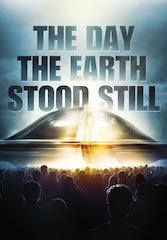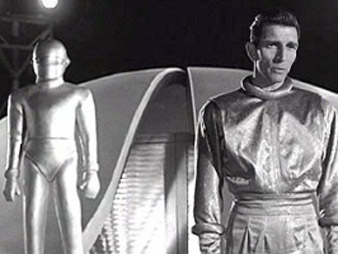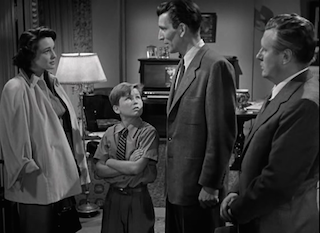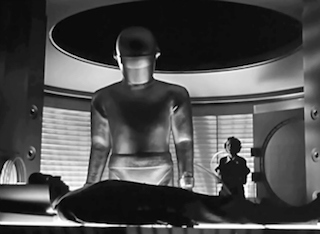 When director Robert Wise’s Sci-Fi drama, The Day the Earth Stood Still, debuted in 1951 it was met with mostly positive acclaim by critics but not as widely seen by audiences of the day. It finished 52nd at the box office in the year it debuted and was passed over for any Oscar recognition. The Academy was only starting to come around on Science Fiction as a legitimate artistic genre—Destination Moon from the year before, 1950, had won an Oscar for Best Visual Effects but is a movie largely forgotten today—and it would take Wise’s film and others to come in the early to mid-50’s to change their attitude entirely.
When director Robert Wise’s Sci-Fi drama, The Day the Earth Stood Still, debuted in 1951 it was met with mostly positive acclaim by critics but not as widely seen by audiences of the day. It finished 52nd at the box office in the year it debuted and was passed over for any Oscar recognition. The Academy was only starting to come around on Science Fiction as a legitimate artistic genre—Destination Moon from the year before, 1950, had won an Oscar for Best Visual Effects but is a movie largely forgotten today—and it would take Wise’s film and others to come in the early to mid-50’s to change their attitude entirely.
Since the movie’s debut, it has taken off in the popular imagination and stand today as one of the most influential early Sci-Fi movies. It consistently makes Top 10 lists of best Sci-Fi movies and is recognized in multiple AFI Top 100 lists. While Robert Wise would go on to make other films that grace AFI’s Top 100 movies of all-time—The Sound of Music and West Side Story—his greatest foray into the Science Fiction genre has connective tissue to AFI’s #1 movie of all-time, Orson Welles’ Citizen Kane. Wise was nominated for an Oscar for working on the film editing of Citizen Kane, and it is widely believed his breakthrough work led to him landing editing jobs for RKO Studios and eventually in the director’s chair for the studio before striking out on his own after 1949’s The Set-Up.
Wise was hired by producer Julian Blaustein after Blaustein had received the green light from 20th Century Fox to produce and write the screenplay. Using the inspiration of the science fiction short story by Harry Bates “Farewell to the Master”, screenwriter Edmund North wrote a script based on Blaustein’s interest in developing a story centered on the fears and suspicions of the atomic age. Much in the same way Gojira, released three years later in 1954, would elucidate Japan’s realized devastation of a nuclear attack, The Day The Earth Stood Still would capture much of the panic of the age and stand as a counterpoint to the rhetoric of McCarthyism, one of the worst legacies to ever have roots in my home state of Wisconsin, and Cold War politics.
 Instead of preaching a message of an impending, foreign invader, the alien presence functions as a clarion call to end violence and focus scientific progress on benefitting all mankind, instead of petty, political squabbles. These sentiments, while being “of the moment” in 1951, would shape even the greatest of political offices. President Ronald Reagan was heavily influenced by the message of the movie and featured references to the movie in meeting with Mikhail Gorbachev in 1985 and in speeches from his second term. In fact, Colin Powell, National Security Advisor during Reagan’s second term, rolled his eyes whenever the topic of the movie was brought up. While it shouldn’t surprise us that a US President who started out as a Hollywood actor would be affected by a Hollywood production, the mere fact it effected a sitting US President shows the power of cinematic storytelling and the metaphorical power of the Sci-Fi genre.
Instead of preaching a message of an impending, foreign invader, the alien presence functions as a clarion call to end violence and focus scientific progress on benefitting all mankind, instead of petty, political squabbles. These sentiments, while being “of the moment” in 1951, would shape even the greatest of political offices. President Ronald Reagan was heavily influenced by the message of the movie and featured references to the movie in meeting with Mikhail Gorbachev in 1985 and in speeches from his second term. In fact, Colin Powell, National Security Advisor during Reagan’s second term, rolled his eyes whenever the topic of the movie was brought up. While it shouldn’t surprise us that a US President who started out as a Hollywood actor would be affected by a Hollywood production, the mere fact it effected a sitting US President shows the power of cinematic storytelling and the metaphorical power of the Sci-Fi genre.
The movie conceives of perhaps a less straight political reading of the movie—although Blaustein has admitted to the movie being a call for a strong United Nations— and more of a wide-ranging appeal to humanity’s need to lay down their arms to pursue more peaceful beneficial pursuits. An even greater reality beckons the viewer to connect with the movie’s spiritual undertones that appeal to humanity’s created longing for transcendence and value beyond the temporal.
When Michael Rennie’s Klaatu descends the ramp of the saucer-shaped spaceship, which was designed with help from famed architect Frank Lloyd Wright, flanked by the eight-foot-tall Gort, played by seven-foot-tall Lock Martin, the fear is palpable and the panic very real. As the Golden Globe-winning score by Bernard Herrmann swells, the mobilized US Army hardly gives Klaatu a chance to speak before he is unceremoniously shot by a jumpy soldier with a rifle. Gort shows his alien powers by disintegrating a tank and the guns of the soldiers. It is only when Klaatu demands he desist that the crowd and the army are spared Gort’s wrath.
After Klaatu is tended to by physicians at Walter Reed Hospital, Klaatu speaks to the President’s secretary, Mr. Harvey, and relays a message that he must meet with all the world’s leaders. He will not divulge the nature of his mission until he can do so. Despite Mr. Harvey’s skepticism, Klaatu insists and Mr. Harvey leaves to try the impossible and gather the world leaders. When he returns the next day, it has been to no avail. World leaders will not convene, and Klaatu is indignant. He cannot fathom the world’s petty squabbles when confronted with something much more important. Mr. Harvey assures him if he only got to know the world’s problems, he would understand why it is impossible for the leaders to convene.
 This small, opening interaction between Klaatu the alien and a government official paints the remaining tensions of the film on surface level reading. When the mere spectacle of an alien life-form in Washington D.C. quickly wears off, Klaatu steals the uniform of an Army major and slips unnoticed into the city. He plans to observe humanity and find out what they are like. He becomes one of them, taking up a room for rent at a boarding house. It is there he meets Helen Benson and her son, Bobby, and he strikes up a quick friendship. Helen’s boyfriend Tom Stephens remains suspicious of John Carpenter, the name Klaatu has taken from the dry cleaner tag on his suit, and it is eventually Tom who will out Mr. Carpenter as Klaatu.
This small, opening interaction between Klaatu the alien and a government official paints the remaining tensions of the film on surface level reading. When the mere spectacle of an alien life-form in Washington D.C. quickly wears off, Klaatu steals the uniform of an Army major and slips unnoticed into the city. He plans to observe humanity and find out what they are like. He becomes one of them, taking up a room for rent at a boarding house. It is there he meets Helen Benson and her son, Bobby, and he strikes up a quick friendship. Helen’s boyfriend Tom Stephens remains suspicious of John Carpenter, the name Klaatu has taken from the dry cleaner tag on his suit, and it is eventually Tom who will out Mr. Carpenter as Klaatu.
Tom is a stand-in for the vices that have gripped the modern American. When he finds out Mr. Carpenter is the alien visitor, he does not seek to learn more but is hopelessly focused on gaining wealth and notoriety from turning in Klaatu to the government, who is desperately searching for him. The American public, in both the eyes of Klaatu and us as the audience, humans are easily gripped by fear and skepticism of the unknown and lust after power and control.
In contrast to Tom and most of the other characters in the film, Helen’s son Bobby becomes the moral compass of the movie. Director Robert Wise has always been known for his primary goal to be connecting with the viewer. And there are few better ways to do that narratively than to attach the fortunes of the main character to a small boy. Bobby’s innocent, child-like faith in Klaatu’s platitudes about reason, science, and kindness toward others underscores the narrative’s more metaphorical reading as a Christ allegory.
First of all, and maybe most apparent, is Klaatu descending from the heavens with a special mission to spare humanity, much the same way Jesus was incarnated into humanity with a mission to rescue humanity. Likewise, he takes the name John Carpenter, the same initials as Jesus Christ and the profession often associated with Jesus. As his mission unfolds, he befriends a woman and a young boy, much like Jesus befriended women and children during his ministry. He commends the faith and moral purity of a small child, has his mission completely misunderstood, and is killed by leading men in power. He rises again and the first witness to his resurrection is a woman, Helen. He delivers a commissioning to spread his message of peace and prosperity throughout all the earth, and then ascends back into heaven with the assurance if his message is not heeded, he will return to eliminate the planet. While that last part differs slightly from biblical orthodoxy in that Jesus will come again to make all things new, not merely destroy sinful humanity, it does speak to the second coming as a time of judgment against the unrighteous. As Wise and Blaustein have both asserted, they hoped the Christ metaphor would be obvious without the eventually added line of Klaatu saying the power of life and death is found only in the Almighty Spirit.
Once the allegorical meaning of the movie is unpacked, it seems at odds with the political message of the movie and the frequent pro-science remarks. However, science and faith are certainly not repellent from one another, nor is faith and politics. The underlying assumption of the movie is all three of these can work together. Klaatu seems to think faith and science trump politics, which he labels as “stupidity” and “petty”, but even Klaatu might be slightly askew in his understanding. Peace and harmony are not merely achieved through the elimination of politics and disagreement but stem from a common currency of love. If Klaatu is a Christological figure, then he would do well to heed the words of Christ regarding his mission:
“Love the Lord your God with all your heart and with all your soul and with all your mind and with all your strength.’ The second is this: ‘Love your neighbor as yourself.’ There is no commandment greater than these.” Mark 12:30-31 (NIV)
Klaatu’s closing speech is full of wrath and “get in line” style moralism but the message of hope found in Christianity is not one of threats of judgment and appeasement of a man-made law, in Klaatu’s case the police force of robots like Gort. Hope and wholeness, shalom, comes from pouring ourselves out in service, counting others better than ourselves, and it leads to flourishing and a peace that is both political and sacred. To use the a common term of a famous movie critic, we are to seek empathy. I think Robert Wise, in his mission to connect with viewers, would love us to see his movie as an empathetic call to hope for our world; both today and into eternity.

